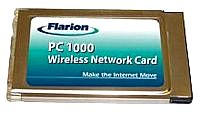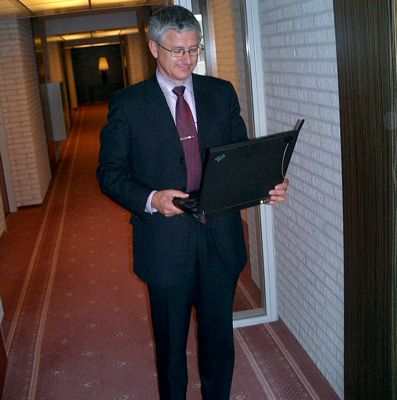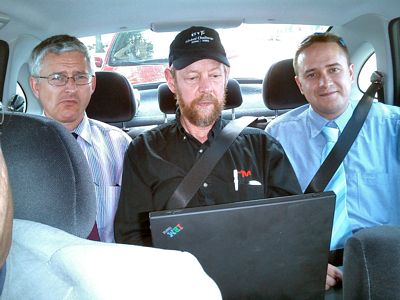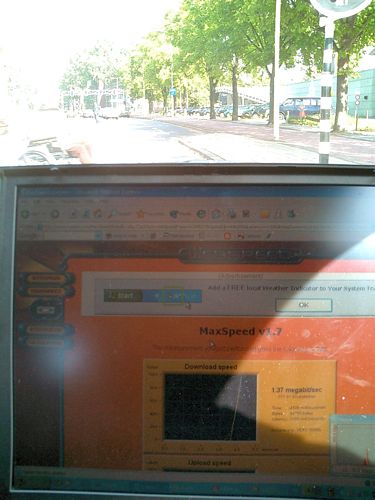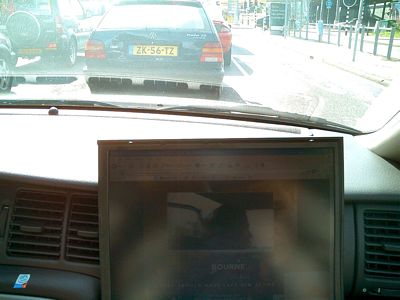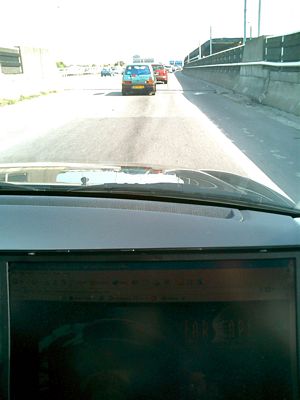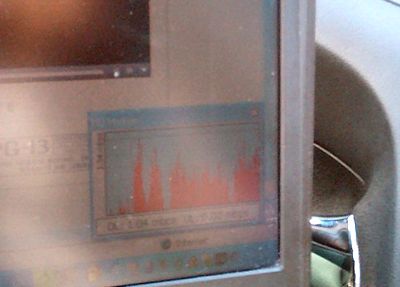Arriving at Amsterdam airport can be quite confusing. A Welcome to Heathrow sign right outside the arrivals terminal? Only in Holland eh?
So it’s 3.40pm on a brilliantly sunny day in The Hague, Holland and I’m watching the new Bourne Supremacy movie trailer on apple.com. What’s unusual though, is that I’m doing this while travelling at 120 kilometres an hour in the outside lane of a Dutch highway, with nothing more than an IBM Thinkpad, a connection to the Flarion Flash OFDM wireless broadband network and a Very Big Grin. Yes folks, the wireless broadband WAN era is finally here, and it rocks!
The story starts a couple of days earlier with a phone call from the Flarion press office to ask whether I’d like to pop over to the Netherlands to test out a new T-Mobile broadband network trial which is running in a suburb of The Hague, and chat to Flarion CEO Ray Dolan? Would I? Regular Ferret readers will know that I’ve been a fan of this technology for a while now, even though I’ve not seen any real life demos. My enthusiasm comes from the fact that the technology was developed at Bell Labs and also comes from a company which clearly puts tech before marketing, which impressed me when I chatted to their execs 18 months ago at the 3GSM Show in Cannes at the start of their European sales push.
At the time the guys were talking about huge performance leaps up to 3 mbps over a wireless network using upgraded cellphone grids, a grandiose claim made even more unbelievable by the fact that the traditional 3G folk at the time were also making all kinds of wild high-speed data claims. What impressed me then though, was the fact that the people I talked to at Flarion clearly knew their stuff and were determined not to oversell the technology just for the sake of getting some press. It was definitely more of a ‘hey don’t worry, we will prove it to you some day’ type of conversation.
To recap, the FlarionFlash OFDM technology – FLASH (Fast Low-latency Access with Seamless Handoff) OFDM (Orthogonal Frequency Division Multiplexing) – is a spread spectrum system which has a number of unique features. Now I’m not tech enough to claim expertise in any of the ‘under the hood’ details, but as far as I understand it, the Flarion stuff has a number of advantages over existing 3G and alternative technologies.
1) It’s very efficient. It requires significantly less spectrum space than existing 3G systems like W-CDMA, because it has a very efficient way of multiplexing the signal. This means more user channels can be provided out of a set amount of spectrum space. It also features a clever dynamic allocation of bandwidth to each user, which can provide guaranteed quality of service as needed. The system envisages users on different plans (e.g. gold, platinum etc) who will achieve different levels of guaranteed throughput depending on what they’re willing to pay. This efficiency also means much less of a problem with contention. They estimate that you can get around 5 times more subscribers onto a FlashOFDM network than existing 3G.
2) Designed from the ground up as an IP network system, whereas existing 3G still retains its circuit switched roots. This reduces the need to translate data between different protocol stacks and means that the system has significantly lower latency than other 3G techs – less than 50ms compared to around 350ms for 3G. Existing 3G also at times will interpret this latency as congestion and throttle back performance, FlarionOFDM doesn’t. Yes you can play a lag-free game of Doom 3 on FlashOFDM while travelling at 120 kph and win!
3) Flash OFDM also has a number of operating states, unlike technologies like WiMax which is either on or off. This can help with things like the battery life of devices, because they can snooze and yet come back to life almost instantly. Again this makes for a better user experience all round although the Flarion people wouldn’t commit to any specific figures on battery life improvement. Bear in mind that the biggest problem with embedding things like WiFi into small devices is the battery drain.
4) FlashOFDM is fast. Very fast. Maximum download speeds are around 3 mbps in bursts, with sustainable averages of around 1.5 mbps. That’s right, 3 times faster than the average home ADSL account. Existing 3G claims 2 mbps, but in reality no one gets more than 384 kbps. Flarion says they get 300 kbps even at the cell edge. Maximum upload speed is also a stonking 700kbps vs 64 kpbs for W-CDMA and 256 kbps for ADSL. Yes, you can run a mobile Web server on a FlashOFDM network very nicely, thank you ma’am.
5) The Flarion hardware and infrastructure requirements are simpler than 3G, which gives direct cost advantages to those who have to install the stuff.
Genial CEO Ray Dolan, tinkers with his digital devices in preparation for an encounter with a large Ferret!
Fast forward to now and I’m sitting down in a hotel lobby in Den Haag to chat to Ray Dolan, Flarion CEO and all round genial dude, to find out how things are progressing with the company’s field tests. Flarion network trials are currently running in Japan with Vodafone, Telstra in Australia, T-Mobile (a Flarion investor!) in Europe and Nextel in the USA. One interesting thing I learn later is that all trials have to be paid for by the test companies, which demonstrates quite a serious level of commitment I reckon. The Nextel trial in Raleigh in the US is the biggest at over 1200 square miles, 100 plus base stations and several thousand users.
I first ask Dolan why it’s taking so long to get the field trials out of the way, bearing in mind that the FlashOFDM technology was developed way back in 1998 and Flarion launched over four years ago? “It’s a complicated process because it involves not just huge global mobile operators, but also the regulatory bodies in each country who license the spectrum,” he explains, “It’s a lot easier to get a deal to put WiFi masts on lampposts across a city, because there’s no licensing involved at all. But the upside is that once we get going we know that the potential market for our technology is huge.”
Another constraint has apparently been the need to get everyone on board, not just the big operators like Nextel and Vodafone, but suppliers like Nokia, Ericsson and Siemens who will be pivotal in supplying the branded equipment that the users will use. The operators made it clear early on that they would only move forward if they could be sure that there would be a wide range of FlashOFDM equipment available from multiple suppliers. Flarion has therefore made it a priority to work with partner Texas Instruments to create IP and chipset technology which can be embedded in all kinds of devices, handheld, luggable and fixed. A 3 mbps enabled iPod or Archos Gmini 400, anyone?
The big question of course is how well this new technology will fit in with existing stuff like WiFi and already deployed 3G platforms? Dolan is keen to stress that a Flarion solution doesn’t mean that companies have to throw away their existing systems and start again. “We’re offering an evolutionary and complementary system to existing services,” he says, “Initially the operator’s efforts were very much motivated by a voice oriented outlook, but now they’re starting to take data very seriously. We expect that they will give their customers a package of options so that they can choose exactly what they want, when they want it. Maybe you’ll use your device on a WiFi basis at home or in the office because the service will come at a cheaper price, but then when you go out on the road it will automatically switch to high speed broadband so that you can keep the same user experience. In a lot of ways we’re really just talking about helping the PC to shrink and go mobile.”
The first Flarion products are PC Cards which fit into laptop computers, but the company hopes that suppliers will roll out a large range of FlashOFDM (got to get a snappier name guys, really) products such as cellphones and PDAs. Already in Japan, Ricoh has created a prototype FlashOFDM phone handset, which hasn’t had a public outing as yet. Flarion executives are, however, keen to distance themselves from the idea of their technology doing everything. For example, it’s clear that they believe the operators will price their services so as to make video streaming prohibitively expensive, simply because a wireless network full of video users will likely grind to a quick halt under the voracious demands of video bandwidth . But that still leaves a huge audio, business applications and Internet access market. A ubiquitous wide area broadband network could, for example, make hard drives in MP3 players redundant since music could be streamed at high quality from literally anywhere – train, boat or your sister’s basement apartment. Interestingly enough, Flarion has also managed to power a wireless broadband network on a plane flying at 500 mph. They somehow managed to keep it working over a 200 mile range too from a strategically placed FlashOFDM ground station. Dolan won’t give any more details though.
So will FlashOFDM replace WiFi? Dolan doesn’t think so. “WiFi gained a lot of buzz because it let you move broadband 100 meters, which was really exciting, and companies like Intel and Cisco have really helped to push it to where it is today. But we’re now moving to a point where, within 2 years, there’ll be a collision between the datacoms people like Dell and Intel and the telecoms companies like Nokia and Ericsson. Both sides come at the high speed data problem from a different perspective and both think that they have the best solution. The telecoms people say it’s easier to add computing power to mobility, while the datacoms guys say it’s easier to add wireless to IP. We’re working with them both and welcome interaction from all sides.”
Political fence walking at its finest. Dolan does clearly feel, however, that WiFi is going to move on from strength to strength over the next couple of years, and that his company will benefit from the user demand for wide area broadband access once people get used to doing away with cables. Embedded wireless chipsets in digital cameras, media players and phones will be just the start. “Every consumer electronics device worth more than $99.00 will eventually be connected to the Internet,” he predicts, “WiFi teaches people that every computer can be untethered, but its limitations will be the tide that we will sail out on.”
The Test Drive
So how does it work? Short answer, very very well. We – veteran tech journalist Guy Kewney, myself and a brace of Flarion executives – drove out into the post lunchtime sunshine of The Hague suburbs with a couple of IBM Thinkpads to see whether the company’s claims would pan out. The trial area is relatively small at the moment, so we only spent around 30 to 40 minutes on the road, but during that time we drove through built up areas as well as a highway stretch. The results were impressive.
Getting the IBMs set up for the start of the test. Joe Barrett, straight talking marketing director of Flarion, makes sure that everything is as it should be.
We’re set. Master Guy K. and his two Flarion bodyguards prepare to conduct the battle of the bandwidth. Will the cell hand-offs really be as seamless as Flarion claim? Notice how well strapped in they are. Is it fear of the driver or the potential data speeds? You can read Guy’s account right here.
A few minutes into the drive and already the Numion test site at www.numion.com shows that we’re achieving 1.37 mbps throughput. We’re starting to sizzle, and it’s not just because the air conditioning’s stopped working.
We’re in to the drive now and on the apple.com site downloading movie trailers like there’s no tomorrow. The Bourne Supremacy (large screen version) zips onto my disc averaging around 1.2 or 1.3 mbps. Cruising around at town driving speeds.
Sorry about the quality of photos, but you try doing this at speed in a darkish vehicle with bright sunlight outside, while trying not to miss anything significant. Hah!
There goes one of the Flarion masts. You can’t see it, but it’s on top of that building. During the whole trip we only really experienced one or two seconds of dropped signal, and it very quickly returned.
Just entering the highway section. Seat belts tightened.
Whoosh, we’re up to 110 kph. Cruising nicely. We peaked at 120 kph which is the legal speed limit. Didn’t want to get any blue lights flashing in the rear view now did we?
1.04 mbps. We peaked at around 2.9 mbps, but generally I would say we were averaging between 700 kbps and 1.2 mbps for most of the time. The movies would download and play within seconds, no matter at what speed we drove or in what area. And I noticed no stutter on hand-off from cell to cell, although that could have been a result of good buffering!
Another Flarion mast flashes past on the speed section.
Getting bored of movies now. Guy is listening to iTunes radio while simultaneously posting his live test copy and downloading movie trailers. We may be the only two people using this test right now (and Flarion couldn’t confirm how many are on the T-Mobile trial for obvious reasons) but we’re certainly making it work for a living.
Later on back in the hotel lobby I continued with some serious Web surfing and made a Skype Out phone call back home using the Thinkpad. All performed flawlessly, although the throughput indoors was slightly slower at around 400 mbps. Sheesh, sluggish wireless connection or what?
All in all, a day worth remembering – if only because one day, whether it’s through Flarion technology or some other as yet unknown, this will be the future of the Internet. Ubiquitous, fast and totally seamless data wherever and whenever we want. Whether that’s a good thing or a bad thing depends on your point of view, doesn’t it?


